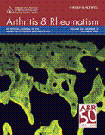Overexpression of toll-like receptors 3 and 4 in synovial tissue from patients with early rheumatoid arthritis: Toll-like receptor expression in early and longstanding arthritis†
This publication reflects only the authors' view. The European Community is not liable for any use that may be made of the information herein.
Abstract
Objective
To analyze the expression, regulation, and biologic relevance of Toll-like receptors (TLRs) 1–10 in synovial and skin fibroblasts and to determine the expression levels of TLRs 2, 3, and 4 in synovial tissues from patients with early rheumatoid arthritis (RA), longstanding RA, and osteoarthritis (OA).
Methods
Expression of TLRs 1–10 in RA synovial fibroblasts (RASFs), OASFs, and skin fibroblasts was analyzed by real-time polymerase chain reaction (PCR). Fibroblasts were stimulated with tumor necrosis factor α, interleukin-1β (IL-1β), bacterial lipopeptide, poly(I-C), lipopolysaccharide, and flagellin. Production of IL-6 was determined by enzyme-linked immunosorbent assay and induction of TLRs 2–5, matrix metalloproteinases (MMPs) 3 and 13 messenger RNA by real-time PCR. Expression of TLRs 2–4 in synovial tissues was analyzed by immunohistochemistry.
Results
Synovial fibroblasts expressed TLRs 1–6, but not TLRs 7–10. Among the expressed TLRs, TLR-3 and TLR-4 were the most abundant in synovial fibroblasts, and stimulation of synovial fibroblasts with the TLR-3 ligand poly(I-C) led to the most pronounced increase in IL-6, MMP-3, and MMP-13. In contrast, skin fibroblasts did not up-regulate MMP-3 or MMP-13 after stimulation with any of the tested stimuli. In synovial tissues from patients with early RA, TLR-3 and TLR-4 were highly expressed and were comparable to the levels of patients with longstanding RA. These expression levels were elevated as compared with those in OA.
Conclusion
Our findings of high expression of TLRs, particularly TLRs 3 and 4, at an early stage of RA and the reactivity of synovial fibroblasts in vitro to TLR ligands suggest that TLR signaling pathways resulting in persistent inflammation and joint destruction are activated early in the disease process.




